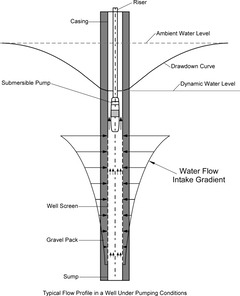Vertical profiling of wells for both flow and water quality characteristics can be an extremely useful technique when it comes to dealing with ongoing well issues, or in final design considerations for a new well. For instance, if you are completing a water supply well in an area with known arsenic impacts to groundwater, vertical profiling of the arsenic levels within the well, combined with flow rates from different water producing zones, can allow the final well design to incorporate sealed zones to reduce the amount of arsenic flow to the well and reduce concentrations to the point where treatment may not be necessary, while still maximizing the available flows to the well. Vertical profiling of a test well for surface contaminants such as nitrate can often lead to adjustments in the depth of seal to prevent low-quality surface water from impacting the well. The most useful vertical profiling incorporates both ambient (non-pumping) and dynamic (under pumping conditions) assessment.
Methods
Flow profiling in a well can be accomplished by means of a flow meter (either a spinner for larger flows or heat-pulse flowmeter for small flows) or dye tracer tests. Flow meters require the removal of the pump for ambient testing and several trips in and out of the hole for dynamic testing. Dye tracer tests can typically be conducted without removal of the pump.
To prevent mixing of water from different zones during water quality testing – especially in fractured rock aquifers – tools such as packers, hydraulic isolation tools or low flow pumps can be used to collect water quality samples at specific intervals identified through earlier flow testing. Differing geologic conditions in different wells will dictate the appropriate methodology.

Ambient testing is conducted under non-pumping conditions to identify the natural flow patterns vertically within the strata intersected by the well. Dynamic testing is conducted under pumping conditions to determine the relative flow and contaminant contribution to the well from various strata under pumping conditions. There can be a substantial difference in flow conditions under non-pumping versus pumping conditions, as the placement of the pump intake will substantially affect the flow which will then tail off below the pump where it reaches a level where there is no flow contribution to the well. These differences are often reflected in differences in overall water chemistry under ambient versus dynamic conditions.
Interpreting Vertical Profiling Results
To properly assess the contribution to overall chemistry in the water produced from the well, a mass balance calculation can be conducted at specific vertical intervals to determine the relative overall contribution of a specific zone to the total chemistry of the produced water. This can be instructive even for non-contaminant constituents such as carbonate and bicarbonate which can contribute to mineral incrustations on the screen sections of the wells. For contaminants such as arsenic or hexavalent chromium, this analysis can be critical to determine well design or well modification considerations to reduce concentrations of the contaminants flowing into the well below levels where treatment may be required.
While vertical profiling may not be appropriate for all situations, in cases where there are known well problems, well chemistry or water quality issues, it can be a useful diagnostic technique to guide well design or modification to minimize the impacts of those problems.
